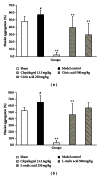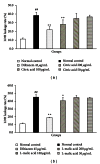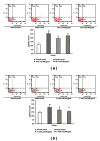The cardioprotective effects of citric Acid and L-malic Acid on myocardial ischemia/reperfusion injury
- PMID: 23737849
- PMCID: PMC3666396
- DOI: 10.1155/2013/820695
The cardioprotective effects of citric Acid and L-malic Acid on myocardial ischemia/reperfusion injury
Abstract
Organic acids in Chinese herbs, the long-neglected components, have been reported to possess antioxidant, anti-inflammatory, and antiplatelet aggregation activities; thus they may have potentially protective effect on ischemic heart disease. Therefore, this study aims to investigate the protective effects of two organic acids, that is, citric acid and L-malic acid, which are the main components of Fructus Choerospondiatis, on myocardial ischemia/reperfusion injury and the underlying mechanisms. In in vivo rat model of myocardial ischemia/reperfusion injury, we found that treatments with citric acid and L-malic acid significantly reduced myocardial infarct size, serum levels of TNF-α, and platelet aggregation. In vitro experiments revealed that both citric acid and L-malic acid significantly reduced LDH release, decreased apoptotic rate, downregulated the expression of cleaved caspase-3, and upregulated the expression of phosphorylated Akt in primary neonatal rat cardiomyocytes subjected to hypoxia/reoxygenation injury. These results suggest that both citric acid and L-malic acid have protective effects on myocardial ischemia/reperfusion injury; the underlying mechanism may be related to their anti-inflammatory, antiplatelet aggregation and direct cardiomyocyte protective effects. These results also demonstrate that organic acids, besides flavonoids, may also be the major active ingredient of Fructus Choerospondiatis responsible for its cardioprotective effects and should be attached great importance in the therapy of ischemic heart disease.
Figures







References
-
- National Pharmacopoeia Committee. Chinese Pharmacopoeia. Vol. 1. Beijing, China: Chemical Industry Press; 2005.
-
- Ao J, Feng H, Xia F. Transforming growth factor and nuclear factor kappa B mediated prophylactic cardioprotection by total flavonoids of fructus chorspondiatis in myocardial ischemia. Cardiovascular Drugs and Therapy. 2007;21(4):235–241. - PubMed
-
- Qu GL. Postdoctoral Research Report. The Chinese Academy of Traditional Chinese Medicine; 2012. The study on pharmacodynamic material basis of Fructus Choerospondiatis and Radix et Rhizoma Rhodiolae Crenulatae .
-
- Liu XG, Chen YS. Component analysis of of fructus chorspondiatis. Chinese Wild Plant Resources. 2000;19(3):35–40.
LinkOut - more resources
Full Text Sources
Other Literature Sources
Molecular Biology Databases
Research Materials

